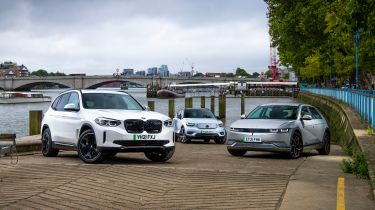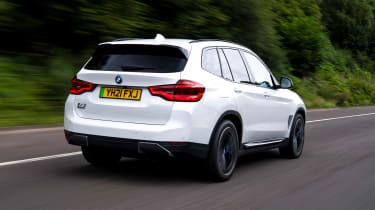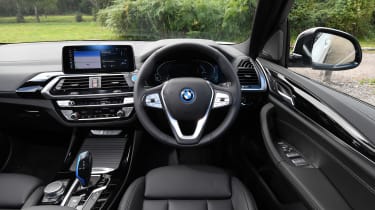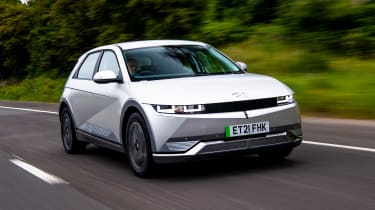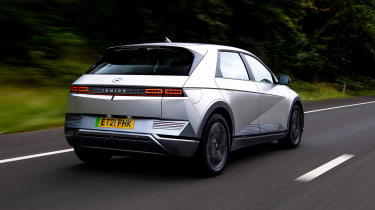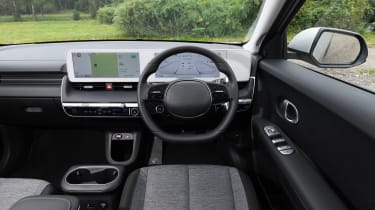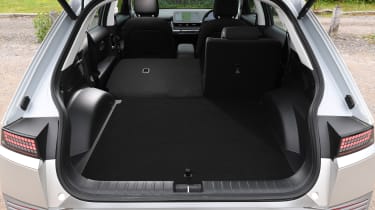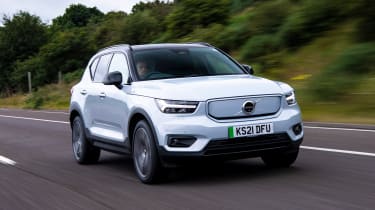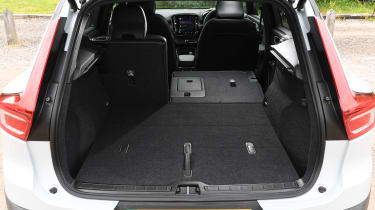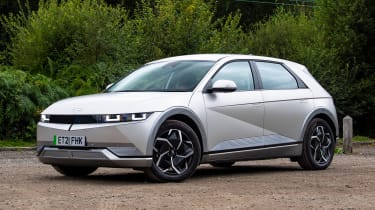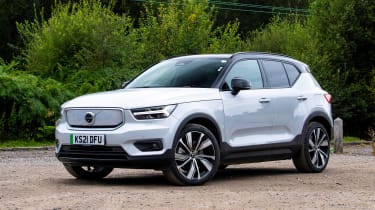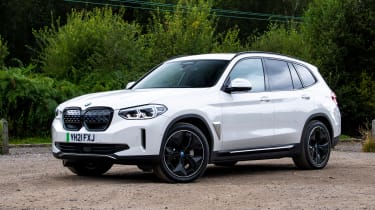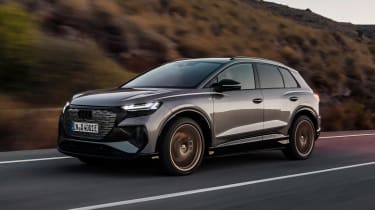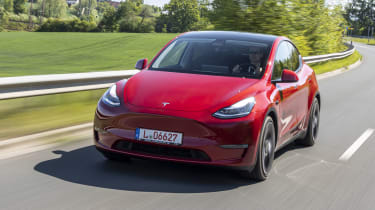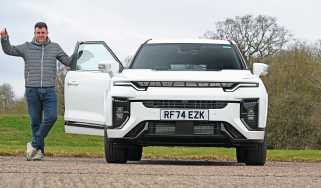BMW iX3 vs Hyundai Ioniq 5 vs Volvo XC40 Recharge: 2021 group test review
The BMW iX3, Hyundai Ioniq 5 and Volvo XC40 Recharge are three of the best electric SUVs on sale - can we pick a winner?
If the automotive world worked logically, it’d be all the small cars becoming electric first. These types of vehicles are frequently driven on short trips in more densely populated areas; their lack of tailpipe emissions would offer the most benefit to public health.
Practically speaking, though, things are different. EV batteries are big and heavy, so you need space for a decent range, and it makes sense to store them under the floor, so a jacked-up ride height is handy to package them.
Throw in buyers’ tastes, and it’s no surprise that SUVs and crossovers dominate the electric landscape so far. One of the latest arrivals is the BMW iX3. It spearheads a rapidly expanding EV range from the firm, and it will be followed by the i4 saloon and iX SUV.
It’ll have its work cut out here though. The Hyundai Ioniq 5 is our reigning Car of the Year. It has already blown away more mainstream rivals, so now it’s time to find out if it can go toe-to-toe with some premium competition.
Volvo’s range might be smaller than its rivals here, but its electric ambitions are every bit as great. All new Volvos since 2019 have featured some form of electrification, and the firm’s entire line-up will be full EV by 2030. The XC40 Recharge is the first to appear – but can it keep up with the competition?
BMW iX3
| BMW iX3 Premier Edition Pro | |
| Price: | £60,945 |
| Powertrain: | 74kWh battery/e-motor, 282bhp |
| 0-62mph: | 6.8 seconds |
| Test efficiency: | 3.5mi/kWh |
| CO2: | 0g/km |
| Annual road tax: | £0 |
The iX3 Premier Edition Pro tested here is priced at £60,945. However, this is a pre-facelift model, which existed only briefly. Order an iX3 today and you’ll receive a facelifted car with slightly tweaked styling; the trims available are M Sport and M Sport Pro, which cost £59,730 and £62,730 respectively.
Used - available now

2020 MINI
5-Door Hatch
42,441 milesAutomaticPetrol2.0L
Cash £17,050
2022 Toyota
Corolla Touring Sports
27,231 milesAutomaticPetrol1.8L
Cash £17,000
2021 Volkswagen
Touran
32,705 milesAutomaticDiesel2.0L
Cash £18,200
2018 SEAT
Ibiza
62,864 milesManualPetrol1.0L
Cash £8,900Design & engineering
BMW slightly mistimed the arrival of the iX3 in the UK, because it went on sale just before a range-wide update. As a result, the car you see here, a pre-facelift model, has almost instantly been replaced with a version that benefits from minor cosmetic upgrades outside (slimmer headlights, revised tail-light graphics and new bumpers) plus a few other minor tweaks.
While we can take all that into account in the final reckoning here, what matters most is that mechanically, the pre-and post-facelift models are identical, and the iX3 benefits from the brand’s fifth generation of electrical drive systems. BMW claims that it’s up to 30 per cent more power-dense than previous systems, with a more compact battery for the capacity and a more efficient motor, which is now in a combined housing with the transmission and power electronics. The single motor here drives the rear wheels, with the iX3 sitting between its two rivals when it comes to output – 282bhp and 400Nm is more than enough for a family SUV, even one that weighs 2,208kg.
Step inside and as with the standard X3, few rivals can touch this electric version for build quality. Everything feels incredibly solid, and the materials are a cut above its rivals here – neither of which feels particularly cheap. The driving position offers a huge range of adjustment, and a panoramic sunroof makes the space feel more open.
Driving
One thing quickly becomes clear from behind the wheel of the iX3: it’s obviously the most engaging of this trio to drive. Negotiate a corner in the BMW and it shows a level of composure lacking in both rivals. Turn in is positive but not nervous, and body roll is well contained.
Compared with the lighter combustion-driven X3s on which it’s based, it doesn’t change direction as easily, but otherwise there’s little to separate them. The weighting of all the controls feels well suited to each other, and although the steering doesn’t offer a huge amount of feedback, it’s more precise than the set-ups of the Hyundai and Volvo.
The powertrain is very slick, too. Throttle response is smooth when crawling in traffic but instant when accelerating hard, at which point the car’s performance feels quicker than the strong 0-62mph time of 6.8 seconds suggests.
What’s more, the iX3 achieves all of this while feeling relaxing and refined. The motor is near silent, and the isolation of knocks and bumps from the suspension is great; it’s not quite as quiet as the larger, ultra-refined Mercedes EQC, but it’s not far off.
The ride is firmer than the Ioniq 5’s by some margin, but it’s never uncomfortable; that’s because the adaptive damping is well set up. Indeed, the resulting high-speed composure brought about by the set-up means it’s an excellent motorway cruiser.
Practicality
The iX3 is physically the largest car here, but while it’s spacious, it doesn’t make use of its footprint as effectively as the cavernous Hyundai. Rear legroom is where this is most obvious; it’s absolutely fine even for taller passengers, but the Ioniq 5 is better still. Headroom is similar in all three cars – great, in other words.
At 510 litres, the iX3’s boot is bigger even than the one in the plug-in hybrid X3. In this company, it runs the Ioniq’s close and is a little more generous than the Volvo’s. A pair of levers in the boot make it easy to fold down the rear seat backs, giving the iX3 the largest total carrying capacity: 1,560 litres to the Ioniq 5’s 1,587 litres and the XC40’s 1,328 litres. There’s space under the boot floor to store the parcel shelf, or the charging cables, but not both at the same time.
Further forward, the iX3’s cabin storage remains quite useful. The door pockets have space for large bottles, while a central compartment hides away the wireless phone charger and a pair of cup-holders when they’re not in use.
Ownership
The latest figures from our annual Driver Power customer satisfaction survey showed that of this trio, BMW scored the lowest for customer satisfaction, and that the Volvo performed the best. As a manufacturer, the Swedish brand ranked ninth out of 29 brands. Hyundai ended a middling 16th, while BMW took 21st.
BMW’s dealer network did better, finishing 11th out of 21. Volvo again performed well taking seventh, while Hyundai’s impressed less, taking 15th. Dive more closely into the figures and it’s the retail side of BMW’s network that lets the side down; the knowledge of salespeople in particular lags behind the best. However, the quality of Hyundai mechanics’ workmanship was ranked second of all the brands covered, next to BMW’s 14th place and Volvo’s 17th.
Running costs
When it comes to efficiency, there’s little to separate the BMW and the Hyundai. Both chalked up identical figures of 3.5mi/kWh – good for the iX3, considering it’s marginally the quicker of the two. That means if you charge up exclusively on a home electricity tariff costing 14p per kWh, fuelling both cars will set you back £823 for 20,000 miles of use.
At 3.1mi/kWh, the Volvo proved to be a heavy user of electricity, but that’s hardly a surprise considering the performance it offers. It’s not a significant increase in cost, though, with 20,000 miles coming in at £929.
Testers’ notes
“Go for top-end M Sport Pro trim and the low-speed exterior sound generator plays a noise developed by famous movie composer Hans Zimmer.”
Hyundai Ioniq 5
|
Hyundai Ioniq 5 Premium RWD | |
| Price: | £41,945 |
| Powertrain: |
73kWh battery/e-motor, 215bhp |
| 0-62mph: | 7.4 seconds |
| Test efficiency: | 3.5mi/kWh |
| CO2: | 0g/km |
| Annual road tax: | £0 |
We're big fans of the Ioniq 5, so much so that we named it our Car of the Year for 2021. That was before we’d sampled the entry-level version you see here, though. The question is, does this single-motor Premium-trim model hold the same level of appeal? It’s priced from £41,945, making it the cheapest car here by some margin.
Design & engineering
View the Ioniq 5 in pictures and you might assume that it’s a Golf-sized hatchback. However, that’s a clever design trick that highlights the car’s neat proportions; at 4,635mm, it’s longer than the XC40 and only slightly shorter than the iX3.
The resulting open feeling inside is suitably luxurious. Even in the black colour scheme of our car’s cabin, it feels so much more airy than its rivals here, and this is helped in no small part by the flat floor and wide dashboard. Quality is great – the feel of the stalks in particular is the best here – although the vast expanses of plain plastic on the doors look a little unfinished. It’s not quite as solid as the near-flawless BMW, but it’s a match for the Volvo.
In contrast to its rivals here, the Ioniq 5 rides on a dedicated electric-vehicle platform. The E-GMP architecture is capable of supporting ultra-rapid 800-volt charging, which gives it an advantage over the other pair – as long as you can find a charger fast enough to keep up. Find a 220kW source and Hyundai quotes a very precise charge time of just 17 minutes and 16 seconds for a 10-80-per-cent top-up of the 73kWh battery.
The Ioniq 5 also supports bi-directional charging. This means that when the car is plugged in, it can use its battery to either charge another EV through a Type 2 connection or even send energy from its battery back to the grid. The latter is ideal in the event of a power cut, and it even opens up the opportunity for homeowners to draw energy from the car at times of day when electricity rates are pricier, and top up the car again when costs drop.
Driving
Unlike previous examples of the Ioniq 5 we’ve driven, this rear-wheel-drive model loses its front-mounted motor, so it’s powered by just one unit at the back. Total output is 215bhp and 350Nm, making it the least potent here on both counts. The Ioniq 5 lacks the startling performance of the Volvo, then, but the quick throttle response and linear power delivery make it feel more than lively enough.
If anything, the rear-wheel-drive car’s more modest acceleration better suits the Ioniq 5’s chassis; the soft suspension is geared towards a relaxed gait. The same can be said of the wheel choice. The 19-inch alloys smother some bumps that the 20-inch items found on higher-spec cars can’t, so this is the Ioniq 5 option that delivers the most ride comfort. The flipside of this is that over long undulations and during hard cornering, the Ioniq’s springs can bounce a little without properly settling, but a neutral balance and precise steering mean that it’s always predictable.
When it comes to regenerative braking, different drivers have different preferences. Some enjoy one-pedal driving, while others would rather a more combustion-like feel. Volvo makes it very hard to switch between its options, because they’re buried in a sub-menu on the touchscreen. In contrast, the Hyundai’s shift paddles behind the steering wheel are a much better solution.
Practicality
Step into the back of the Ioniq 5 and it’s easy to see the benefits of its scaled-up hatchback proportions, with legroom that’s genuinely limo-like. The iX3 is far from cramped, yet the Hyundai offers around 50mm more kneeroom, and the flat floor gives plenty of space for feet across all three seats. Headroom is great too – roughly the same as in the BMW – and the backrests can recline to give even more space if needed. The cabin is filled with useful touches, including a large glovebox that opens like a drawer, and a couple of deep cup-holders between the front seats.
At 527 litres, the boot is larger than both the BMW’s and the Volvo’s. The area it covers is huge, but it’s fairly shallow with a high floor, which makes carrying bulky items a little trickier, particularly compared with the iX3. On the plus side, the bumper is shallow, so it doesn’t get in the way during loading.
Ownership
The Ioniq 5 is the only car here to benefit from a five-year, 100,000-mile warranty. By contrast, the BMW’s package works on an unlimited-mileage basis, but only for three years, while the XC40 has Volvo’s standard three-year/60,000-mile warranty.
On paper, the Ioniq 5 has the lowest insurance group of the three – Group 41 versus 42 for the Volvo and 50 for the BMW. However, based on our annual quotes, there’s barely 10 per cent in it between the Ioniq and the priciest XC40.
Running costs
At 300 miles, the Ioniq 5 has the best official range of this trio, which means longer journeys will require the least amount of forward planning when it comes to finding suitable charging spots. In the real world, we estimate a figure of 254 miles – five miles fewer than the BMW and beating the Volvo’s 233 miles.
All three cars are extremely cheap for company car users, falling into the lowest one per cent Benefit-in-Kind tax bracket. The Ioniq’s purchase price means it will be the cheapest company car option; a higher-rate earner will face deductions of £168 a year, compared with £227 for the Volvo and £259 for the BMW, but all are thousands of pounds cheaper than similarly sized petrol SUVs. For the 2022/23 tax year, each car will climb into the two per cent band, so those figures – and the gaps between them – will double.
Testers’ notes
“One suggestion for Hyundai come facelift time: install a rear window wiper. In heavy rain the rear view is restricted – even at motorway speeds.”
Volvo XC40 Recharge
| Volvo XC40 Recharge Twin Pro | |
| Price: | £56,700 |
| Powertrain: | 78kWh battery/twin motor, 402bhp |
| 0-62mph: | 4.9 seconds |
| Test efficiency: | 3.1mi/kWh |
| CO2: | 0g/km |
| Annual road tax: | £0 |
The XC40 Recharge that we’re testing here is in the top-spec Twin Pro trim. While the range starts from £49,950, the Twin Pro weighs in at £56,700. However, metallic paint, a £585 option
on the base car, is offered free of charge here.
Design & engineering
While a fully electric powertrain is a relatively new arrival to the Volvo line-up, we have seen this technology before. That’s because the electric XC40 – and the new C40 coupé SUV – share their running gear with the Polestar 2. The XC40 Recharge uses the same Compact Modular Architecture and comes with a 78kWh battery.
Less potent versions of the XC40 will appear at a later date, but Volvo’s first all-electric model has launched in range-topping P8 Twin guise, which is a curious move, considering its price point. It packs two motors – one for each axle – and produces figures that wouldn’t look out of place in a sporty saloon. Total outputs stand at 402bhp and 660Nm of torque.
Inside, the XC40 sports the typically clean, understated feel of the rest of the Volvo range. The use of carpet on both the floor and the doors avoids the large expanses of hard surfaces in the Hyundai Ioniq 5, and it pushes Volvo’s sustainability angle, too; the material is created from recycled bottles. The driving position is the most SUV-like here; the high-set seat means that you’re given a commanding view of the road ahead. Things are less impressive behind, though, where large C-pillars hamper visibility over the shoulder.
Driving
Just getting the XC40 going might seem like an odd process for EV newcomers. As in a Tesla, there’s no key or starter button, because the Recharge is on as soon as you get in – simply nudge the gear selector into drive or reverse and away you go.
The XC40 has one stand-out area, and that’s performance. It takes just 4.9 seconds to cover the 0-62mph sprint, comfortably quicker than its rivals here, and 0.3 seconds quicker than even the most potent Ioniq 5.
You could argue that it’s almost needlessly fast for the type of car that it is; when the less potent line-up is introduced, they will be a closer match to the XC40’s rivals here, and one of these will be better to recommend.
Typical of all the latest electric models, refinement is a plus point of all three of these cars – especially when compared with similarly sized petrol and diesel models. Each is smooth and their motors near-silent, but the fact that the T8 is so hushed despite having two motors, as opposed to the single set-up used by the other pair, is impressive. The lack of any engine sound makes wind and particularly road noise more conspicuous compared with the standard XC40 models, but it’s still pleasingly muted inside.
The 2.1-tonne XC40 is fairly hefty in this company, and with the smallest footprint of the three, it’s least at home when hustled through the corners. It’s not wayward as such – there’s less body roll than in the Ioniq 5 – but it does feel lethargic and just a little more top-heavy than the other two. The steering is very light, which is great in town, but less confidence-inspiring on the road.
Practicality
It's worth bearing in mind here that the Volvo is the shortest car of this trio (it’s 210mm shorter than the Ioniq 5 and 309mm shorter than the iX3) so it’s not a surprise to discover that it’s both the least spacious inside and has the smallest boot. There really isn’t much in it for passengers, though – at least compared with the BMW. Rear kneeroom is just a couple of millimetres short of the iX3’s, and headroom is pretty much the same.
Interior storage is well thought out, for the most part. There’s a removable waste bin in the centre console, and large door pockets, too. The glovebox is fairly small, however. Devices are easy to top up thanks to four USB-C ports (two in the front, two in the back) plus a 12-volt socket.
At 465 litres, the XC40’s boot is the smallest here. However, the Volvo does benefit from a modest 31-litre storage space under the bonnet, too. The main space is accessed by a standard powered tailgate, while a load-protection net also comes as standard. The seats fold in a 60:40 split and lie almost completely flat when not in use.
Ownership
The electric version of the XC40 has yet to be tested by Euro NCAP, but the combustion-powered version achieved a full five-star rating in 2018. Its Adult Occupant protection score of 97 per cent was the highest of any car tested that year. The petrol and diesel versions of the iX3 also managed a five-star rating when they were tested a year earlier, while the Ioniq 5 has yet to be rated.
Running costs
When it comes to residuals, this trio are closely matched. After three years and 36,000 miles, the XC40 is – just – expected to lose the most value, clinging onto 55.2 per cent of its asking price; the Ioniq 5 edges it with a figure of 56.1 per cent. While the Premier Edition iX3 holds on to 61.4 per cent, the M Sport trims sold today are a little weaker. Still, the Pro model’s 57.8 per cent is the best here.
With EVs having fewer consumable parts than a combustion-engined car, servicing them is cheap. Should you finance the XC40 through the Care by Volvo package, all costs are included in the monthly rates. Pay for it by cash outright, and its first annual service costs as little as £100. The BMW is the priciest, with three years’ worth of work coming to £540. The Hyundai splits the two, at £275.
Testers’ notes
“The XC40’s ergonomics are mostly great, but the sunroof is operated by a touch-sensitive slider in the roof. It’s fiddly – a proper button would be better.”
Verdict
First place: Hyundai Ionq 5
Great though each of these EVs is, choosing a winner isn’t difficult. The simple fact is that the Hyundai Ioniq 5 is a significantly cheaper car than either of its rivals here, but judge it on either its superficial or technical strong points, and it really doesn’t feel like the budget option. Badge snobbery aside, it’s really hard to think of a valid reason to choose the premium options over our deserved winner.
Second place: Volvo XC40 Recharge
It's a close call between the Volvo and BMW for the runner-up spot, but the XC40 takes it on account of much lower monthly payments than the BMW – especially considering the level of cover that the Volvo’s package provides. It’s only marginally less efficient, despite offering significantly stronger performance, and while it’s not quite as spacious, it’s still a fair size for a family EV.
Third place: BMW iX3
There's no doubt that the BMW iX3 is a great electric car, and there’s no shame in finishing third in this company. BMW fans looking to make the switch to electric will not be disappointed by the quality feel, nor the fact that it’s the best choice here for the keen driver. But on the type of finance deals that so many new-car buyers opt for, it looks like an expensive prospect in this company.
Also consider...
- New: Audi Q4 e-tron Edition 1 50 quattro
- Price: £56,850
- Power: 82kWh/2-motor, 295bhp
Audi’s challenger in this class is closest in philosophy to the Hyundai, because it rides on an EV-only platform. As a result, it’s also spacious inside, and although it isn’t as sharp to drive as the BMW, it starts at a much more affordable price.
- New: Tesla Model Y Long Range AWD
- Price: £55k (est)
- Power: 75kWh/2-motor, 434bhp
It’s only a matter of time before one of the most hotly anticipated options in this class makes its UK debut. Tech is similar to the Model 3’s, so we expect class-leading performance, infotainment tech and the benefit of Tesla’s brilliant charging network.
Figures
| Hyundai Ioniq 5 Premium 73kWh RWD | Volvo XC40 Recharge Twin Pro |
BMW iX3 Premier Edition Pro | |
| On the road price/total as tested | £41,945/£42,895 | £56,700/£56,700 |
£60,945/£60,945 |
| Residual value (after 3yrs/36,000) | £23,548/56.1% | £35,477/55.2% | £37,420/61.4% |
| Depreciation | £18,397 | £21,223 | £23,525 |
| Annual tax liability std/higher rate | £84/£168 | £113/£227 | £130/£259 |
| Annual elec. cost (12k/20k miles) | £494/£823 | £557/£929 | £494/£823 |
| Insurance group/quote/road tax cost | 41/£727/£0 | 42/£800/£0 | 50/£740/£0 |
| Servicing costs | £275 (3 yrs) | £0 (3 yrs) | £540 (3 yrs) |
| Length/wheelbase | 4,635/3,000mm | 4,425/2,702mm | 4,682/2,990mm |
| Height/width | 1,605/1,890mm | 1,651/1,910mm | 1,565/2,011mm |
| Powertrain | E-motor/li-ion battery | 2 x e-motors/li-ion batt |
E-motor/li-ion battery |
| Peak power | 215bhp | 402bhp | 282bhp |
| Peak torque | 350Nm | 660Nm | 400Nm |
| Transmission | Single-speed/rwd | Single-speed/4WD |
Single-speed/rwd |
| Battery capacity/usable | 73/72.6 kWh | 78/75 kWh | 80/74 kWh |
| Boot capacity (seats up/down) | 527/1,587 litres | 452/1,328 litres | 510/1,560 litres |
| Kerbweight/payload/towing capacity | 1,910/520/1,600kg | 2,113/462/1,500kg |
2,208/462/750kg |
| Turning circle | 12 metres | 11.8 metres | 12.4 metres |
| Basic warranty/recovery | 5 yrs (unlimited)/1yr | 3 yrs (60,000)/3yrs |
3 yrs (unlimited)/3yrs |
| Driver Power manufacturer/dealer pos | 16th/15th | 9th/7th | 21st/11th |
| NCAP: Adult/child/ped./assist/stars | N/A | 97/87/71/76/5 (’18)* |
93/84/70/58/5 (’17)* |
| 0-62mph/top speed | 7.4 secs/115mph | 4.9 secs/112mph |
6.8 secs/112mph |
| AE economy (miles/kWh)/range | 3.5/254 miles | 3.1/233 miles | 3.5/259 miles |
| Claimed range (WLTP) | 300 miles | 256 miles | 281 miles |
| Charging capability | 3.6kW/11kW/220kW | 3.6/11kW/150kW | 3.6/11/150kW |
| Charging time | 23h 15min/10h 53min/ 17min (10-80%) | 21h/7h 30min/40min (10-80%) |
22h 30min/11h 45min/ 27 min (10-80%) |
| Actual/claimed CO2/tax bracket | 0/0g/km/1% | 0/0g/km/1% | 0/0g/km/1% |
| Airbags/Isofix/park sensors/camera | Seven/yes/f&r/yes | Seven/yes/f&r/yes | Six/yes/f&r/yes |
| Auto/lane keep/blind spot/AEB | Yes/yes/yes/yes | Yes/yes/yes/yes | Yes/yes/yes/yes |
| Climate control/cruise control | Yes/adaptive | Yes/adaptive | Yes/adaptive |
| Leather/heated seats | No/yes | No/yes | Yes/yes |
| Metallic paint/LED headlights | £585/yes | £0/yes | £0/yes |
| Keyless go/powered tailgate | Yes/yes | Yes/yes | Yes/yes |
| Sat-nav/digital dashboard | Yes/yes | Yes/yes | Yes/yes |
| DAB radio/connected apps | Yes/yes | Yes/yes | Yes/yes |
| Wireless charge/CarPlay/Android Auto | Yes/yes/yes | Yes/yes/yes | Yes/yes/yes |
